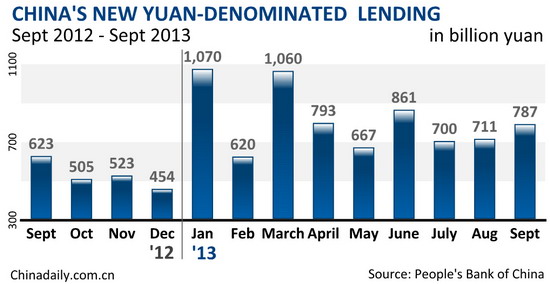BEIJING -- China's new yuan-denominated lending in the first three quarters this year reached 7.28 trillion yuan ($1.18 trillion), an increase of 557 billion yuan from a year earlier, according to a statement issued by the central bank on Monday.
The new lending increase was the second highest in the country's history, only after that for the same period of 2009, when lending stood at 8.67 trillion yuan.
According to the People's Bank of China (PBOC), new yuan loans in September stood at 787 billion yuan, 164.4 billion yuan more than a year ago.

"Although the new loans reading was significantly above market expectations compiled by Bloomberg, the consensus reading (675 billion yuan) was revised up to around 800 billion yuan last week as more information became available, so markets won't be too surprised," said Lu Ting and Zhi Xiaojia, China economists with Bank of America Merrill Lynch, in a research note.
M2, a broad measure of money supply that covers cash in circulation and all deposits, rose 14.2 percent year on year to 107.74 trillion yuan at the end of September, according to the Chinese central bank.
The narrow measure of money supply (M1), which covers cash in circulation plus demand deposits, expanded 8.9 percent last month. The growth rate was 1 percentage point lower than the previous month.
China's yuan-denominated deposits totaled 103.09 trillion yuan by the end of September, an increase of 14.6 percent from a year earlier.
In the first three quarters this year, new yuan deposits amounted to 11.27 trillion yuan. In September, new yuan deposits rose by 1.63 trillion yuan, decreasing 26.7 billion yuan from a year earlier.
China's foreign reserve increased by $160 billion in the third quarter this year to reach $3.66 trillion at the end of September, according to the statement.
"Overall we saw stable and robust credit growth in September, and capital flowed into China again in the third quarter of 2013 despite capital flight in many other emerging economies on fear of an incoming US QE [quantitative easing] tapering," Lu and Zhi said in the note emailed to Xinhua.
They maintained that policy easing by China will taper off, but there will be a small risk of imminent tightening or a reversal of policies.
Given the current growth momentum, the Chinese government could easily achieve its 7.5-percent expansion target, but CPI inflation will be edging towards the cap at 3.5 percent and house prices are rising at an annual rate of around 9 percent, they said.
"More specifically, we expect no moves on reserve requirement ratio (RRR) or policy rates, and we expect the PBOC to continue using open market operations to deliver stable interbank rates," they said, referring to the RRR for lenders.
